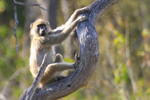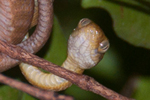
The yellow slime mold Physarum polycephalum exploring a petri dish. Slime deposits to the left of the image tell the slime mold where it has previously explored. Photo by: Audrey Dussutour.
How do you navigate space efficiently without a brain? Slime, according to a surprising new study in the Proceedings of the National Academy of Sciences (PNAS) of a brainless slime mold named Physarum polycephalum. Scientists at the University of Sydney have discovered that the mold secretes slime as an ‘external spatial memory’ to make sure it doesn’t end up going around in circles.
“Our data show that spatial memory enhances the organism’s ability to navigate in complex environments,” the researchers write.
Physarum polycephalum is a shade-loving slime that can often be found in logs or in the leaf litter. Seeking microbes as food, the mold also must avoid light and salt. But since Physarum polycephalum lacks a brain, scientists pondered how it found its way around.
“As it moves, the [slime mold] leaves behind a thick mat of nonliving, translucent, extracellular slime,” the scientists write, adding that when the mold is foraging it “strongly avoids” areas covered it in its own slime.
To test how its slime might be related to movement, the researchers began with a Y-shaped trap including food at the end of each branch. They found that when one end was covered with a slime mat, 39 out of 40 molds avoided that branch and went the other way. In other words, the mold almost always avoided going back over areas that were already covered in its slime. The scientists refer to this as a “choice,” since the mold will in fact traverse these areas again, but only if it has no other option.
“The slime mold’s behavioral response strongly suggests that it can sense extracellular slime upon contact, and uses its presence as an externalized spatial memory system to recognize and avoid areas it has already explored,” the researchers write.
External memory may sound like an oxymoron, but scientists have found that ant pheromones are another kind of external memory. Ants deposit chemicals containing important bits of information that they or other ants will encounter later, much like how humans use sticky notes to remind themselves of important tasks such as ‘clean the fridge’ or ‘call the doctor.’ The slime mold does something similar, only containing less information; its as if it leaves a sign behind saying, ‘you’ve already been here.’ One could think of this like Theseus trailing thread behind him in the Minotaur’s maze so he knew which way he had come.
Next, the researchers sought to test just how effective the slime mold’s behavior was increasing its navigational efficiency by setting up a U-shaped trap that is commonly used to test robots. At one end of a petri dish they placed attractive food that could be sensed by the slime mold, but this was blocked by a wall in a U-shape facing the mold. If the petri dish was coated in a slime mat prior to the test, the scientists found that the mold would take almost 10 times longer than if the petri dish was clean. In other words, the presence of the slime mat masked the mold’s ability to use its external memory properly, significantly decreasing the molds ability to quickly navigate around the U-shape wall keeping it from the food. When the petri dish was clean not only was the slime mold quicker at reaching the food, but it often tracked close to the most efficient route around the walls.
“Even an organism without a (central) nervous system can effectively navigate complex environments,” the researchers write.
They conclude that the study provides “strong support” that external spatial memory, such as chemicals deposited by ants or slime by a mold, was “the first step toward the evolution of memory in organisms with more sophisticated neurological capabilities than our slime mold.”
CITATION: Chris R. Reid, Tanya Latty, Audrey Dussutour, and Madeleine Beekman. Slime mold uses an externalized spatial “memory” to navigate in complex environments. PNAS. 2012. www.pnas.org/cgi/doi/10.1073/pnas.1215037109
Related articles
Photos: new mammal menagerie uncovered in remote Peruvian cloud forest

(10/03/2012) Every year scientists describe around 18,000 new species, but mammals make up less than half a percent of those. Yet mammal surprises remain: deep in the remote Peruvian Andes, scientists have made an incredible discovery: a rich cloud forest and alpine grassland ecosystem that may be home to no less than eight new mammal species. Although most of these new mammals are currently under study—and have not been officially described yet (a process which can take several years)—lead scientists, Horacio Zeballos of Peru and Gerardo Ceballos of Mexico are certain they have uncovered a small forest, surrounded by deforestation and farmland, that shelters a remarkable menagerie of mammals unknown to scientists until now.
Mr. Darcy and the Manic Pixie Dream Girl: monkeys display distinct personality types

(10/01/2012) Remember the ‘man with no name’ played by Clint Eastwood in A Fistful of Dollars, Mr. Darcy in Jane Austen’s Pride and Prejudice, or the bubbly cute girl in every romantic comedy from Legally Blonde to Breakfast at Tiffany’s? Each of these characters represent an over-the-top type of human personality—loner (man with no name), aloof (Darcy), and nice (the bubbly cute girl)—but a new study in the Proceedings of the National Academy of Sciences (PNAS) finds that it’s not only humans that show such distinct types, but baboons as well. Studying 45 female chacma baboons in Botswana’s Moremi Game Reserve over seven years, the researchers found that such personality types, unrelated to social statues, helped to determine the animals’ overall sociability and the stability of their relationships.
Arachnopocalypse: with birds away, the spiders play in Guam

(09/17/2012) The island of Guam is drowning in spiders. New research in the open-access journal PLOS ONE has found that in the wet season, Guam’s arachnid population booms to around 40 times higher than adjacent islands. Scientists say this is because Guam, a U.S. territory in the Pacific, has lost its insect-eating forest birds. Guam’s forests were once rich in birdlife until the invasion of non-native brown tree snake (Boiga irregularis) in the 1940s decimated biodiverse bird communities. Now, the island is not only overrun with snakes, but spiders too.
Sacrificial squid has unique way of deterring predators
(09/04/2012) Octopoteuthis deletron—this deep-dwelling, unassuming little squid may appear plain and boring, but when threatened, it has a peculiar way of defending itself. This foot-long invertebrate behaves a bit differently than most of its close cousins: it drops its arms.
Unidentified poodle moth takes Internet by storm

(08/29/2012) A white moth from Venezuela that bears a striking resemblance to a poodle has become an Internet sensation, after cryptozoologist Karl Shuker posted about the bizarre-looking species on his blog. Photographed in 2009 in Venezulea’s Canaima National Park in the Gran Sabana region by zoologist Arthur Anker from Kyrgyzstan, the white, cuddly-looking moth with massive black eyes has yet to be identified and could be a species still unknown to science.